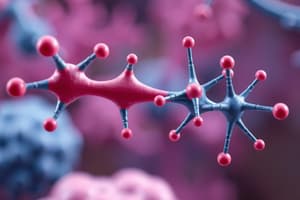Podcast
Questions and Answers
What is the function of an antagonist?
What is the function of an antagonist?
- Blocks the action of the agonist (correct)
- Modifies the cellular proteins
- Causes an action opposite to that of the agonist
- Activates a receptor to produce a biological response
What is the difference between endogenous agonists and exogenous agonists?
What is the difference between endogenous agonists and exogenous agonists?
- Endogenous agonists are produced by the body, while exogenous agonists are not (correct)
- Endogenous agonists have a stronger biological response than exogenous agonists
- Endogenous agonists have no impact on biological responses
- Endogenous agonists bind to different receptors than exogenous agonists
What is the characteristic of a full agonist?
What is the characteristic of a full agonist?
- Activates a receptor with the maximum response (correct)
- Blocks the receptor from being activated
- Binds to a receptor but does not activate it
- Activates multiple receptors simultaneously
What is the endogenous agonist for dopamine receptors?
What is the endogenous agonist for dopamine receptors?
What is the role of co-agonists in NMDA receptor activation?
What is the role of co-agonists in NMDA receptor activation?
What is the function of biased agonists?
What is the function of biased agonists?
What is the role of partial agonists like buprenorphine in opiate dependence treatment?
What is the role of partial agonists like buprenorphine in opiate dependence treatment?
What is the unique characteristic of superagonists?
What is the unique characteristic of superagonists?
What is the mechanism of action of irreversible agonists?
What is the mechanism of action of irreversible agonists?
What is the significance of functional selectivity in ligands' behavior?
What is the significance of functional selectivity in ligands' behavior?
What is the function of selective agonists?
What is the function of selective agonists?
What is the role of inverse agonists?
What is the role of inverse agonists?
What is the effect of agonists on receptors?
What is the effect of agonists on receptors?
What does the EC50 value measure?
What does the EC50 value measure?
What does the therapeutic index measure?
What does the therapeutic index measure?
Study Notes
Agonist Types and Mechanism of Action
- A drug can act as a full agonist in some tissues and as a partial agonist in others, depending on receptor numbers and differences in receptor coupling.
- NMDA receptor activation requires the binding of both glutamate, glycine, and D-serine co-agonists.
- Selective agonists are specific to a certain type of receptor, such as buspirone for serotonin 5-HT1A.
- Partial agonists like buprenorphine are used to treat opiate dependence due to their milder effects and lower abuse potential.
- Inverse agonists bind to the same receptor site as an agonist and inhibit the constitutive activity of the receptor.
- Superagonists can produce a greater response than the endogenous agonist for the target receptor.
- Irreversible agonists bind permanently to a receptor through the formation of covalent bonds.
- Biased agonists bind to a receptor without affecting the same signal transduction pathway.
- Oliceridine is a µ-opioid receptor agonist described to be functionally selective towards G protein and away from β-arrestin2 pathways.
- Ligands can concurrently behave as agonist and antagonists at the same receptor, leading to terms like "functional selectivity" and "protean agonism".
- Agonists induce a conformational change and activate the receptor, with unique mechanisms of action depending on the receptor activated and the response needed.
- Potency is inversely related to the EC50 value, which measures the concentration of agonist needed to elicit half of the maximum biological response. Therapeutic index measures the margin of safety between the dose needed for the desired effect and the dose that produces unwanted side-effects.
Studying That Suits You
Use AI to generate personalized quizzes and flashcards to suit your learning preferences.
Description
Test your knowledge of agonist types and mechanisms of action with this quiz. Explore the various forms of agonists, from full and partial agonists to biased and superagonists, and understand their roles in pharmacology and drug development.




